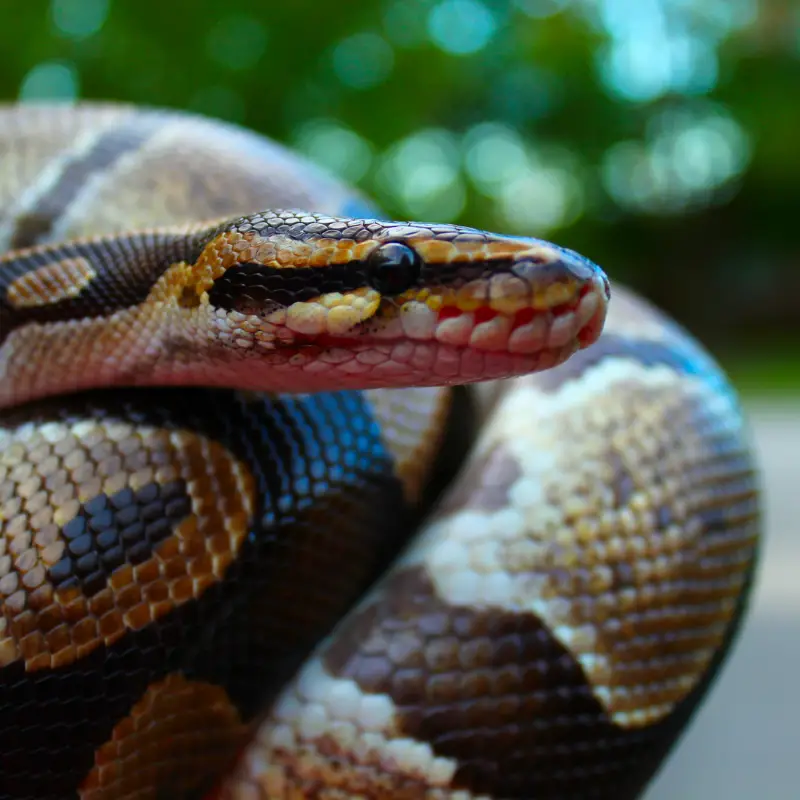The characteristics and docile nature of the ball pythons have made him one of the world’s most popular pet snake options. Also known as Royal pythons, these snakes are one of the smallest species of African pythons. Ball python was given this name as these snakes often tend to curl up into a ball when they feel threatened. The title Royal Python was conferred because, in ancient times, rulers used to wear these snakes as jewellery.
Among all the snakes, ball pythons hold the record of living the longest. Philadelphia zoo housed a ball python that lived for 47 years. However, the general lifespan of this snake is about 20 to 30 years. That means if you think about getting a ball python for yourself, understand the seriousness of the responsibility first. Purchasing a ball python as a pet should not be a fickle decision that you make on a whim.
Species Overview:
- Scientific Name: Python regius
- General Habitat: Grassland or Savanna
- Length: 1 to 1.83 meters
- Life Span: 20 to 40 Years
- Venomous: No
- Distribution: Africa
Geographic Range
In open forests and grasslands of Central and West Africa, ball pythons are found. In countries like Senegal, Guinea, Sierra Leone, Liberia, Ivory Coast, Mali, Guinea-Bissau, Ghana, Nigeria, Chad, Cameroon, Uganda, and Sudan, you can find ball pythons almost everywhere. These snakes are native to the province of Sudan that is located in the Nile. The Bahr El Ghazal and Nuba Mount region is also a well-known habitat of these snakes. These snakes can also be seen in the everglades of Florida.
Habitat
Ball pythons are terrestrial creatures that are primarily found in the Savanna grassland or open forest floor. You can also spot these snakes in areas that have been cleared for farming. Ball python’s love the dark, damp underground caves. While these snakes have not been described as arboreal, you can find them relaxing on the tree branches as well and basking in the sun.
Physical Description
The length of the ball python in captivity and the wild very significantly. While you can frequently find 6-foot long ball pythons in the wild in captivity, the snakes grow up to 4 to 5 feet. There are reports of ball pythons in the wild that are much longer than this. The length of the hatchlings of the snake ranges from 10 inches to 17 inches. Within three years of captivity, a baby ball python can grow more than 3 feet in length.
The colour markings of the ball python vary from snake to snake. Juvenile snakes generally have yellow or are yellowish-brown in colour. Some of these young snakes can also develop a light chocolate brown colour. However, mostly you can find dark to medium chocolate brown colour markings on their bodies.
The colour of the ventral surface of the snake’s body ranges from pale Grey to off-white. The posterior section of this snake, as well as the tail, is of darker colours. However, you can notice a pale-coloured vertebral stripe that stops just before the tip of the tail. Some snakes showcase multiple grey flakes on their ventral surface. However, this pattern is disruptive, and considerable variations can be seen from one snake to the next.
Eyes
The eyes of the snake are near entirely black. However, if you conduct a closer inspection, you will be able to spot the dark-coloured pupil and iris. The neck of the snake is slender compared to the heavyset head. That is what gives the snakes their unique look.
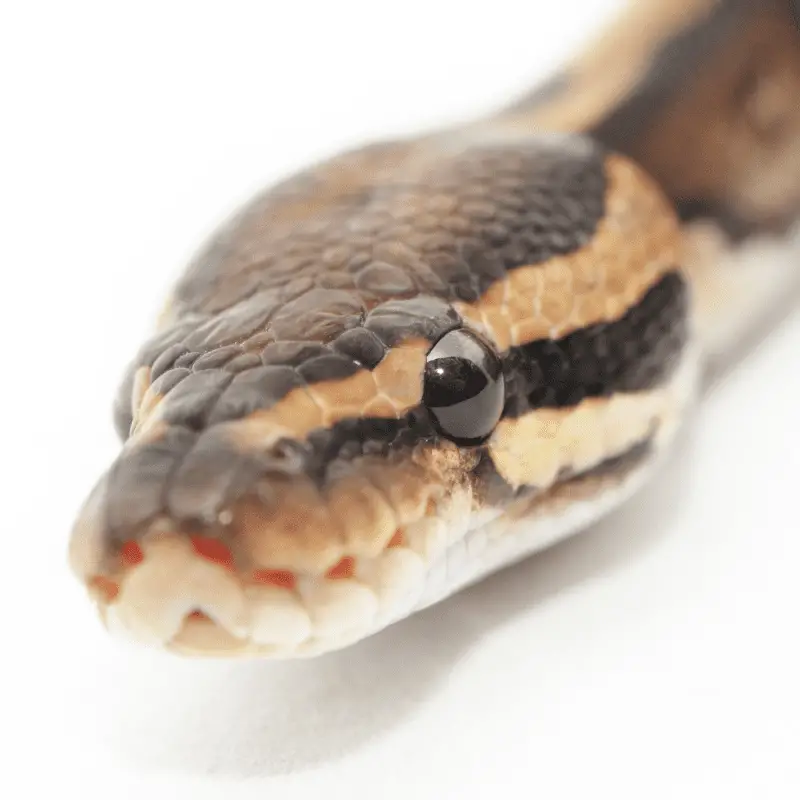
Compared to the male snakes, adult female snakes also have a broader and longer jaw. This physical feature may make the female snakes better hunters compared to the male ball pythons. During copulation, male ball pythons use their spurs to grip the females. However, compared to females, male snakes tend to have more prominent spurs.
Development
The female ball python is oviparous and generally lays 1 to 11 large eggs. After laying eggs, female ball pythons tend to coil around the clutches of their eggs until they hatch.
How long do ball python eggs take to hatch?
The eggs of the ball pythons take about two months to hatch.
Egg Protection
Unlike other snakes, the female ball pythons protect their eggs from predators till they hatch. The hatchlings start to live an independent life immediately after their birth. However, they remain in the vicinity of their nest for months after they are born.
When the hatchlings get ready to come out of the eggs, baby ball pythons use their egg tooth to tear through the shells.
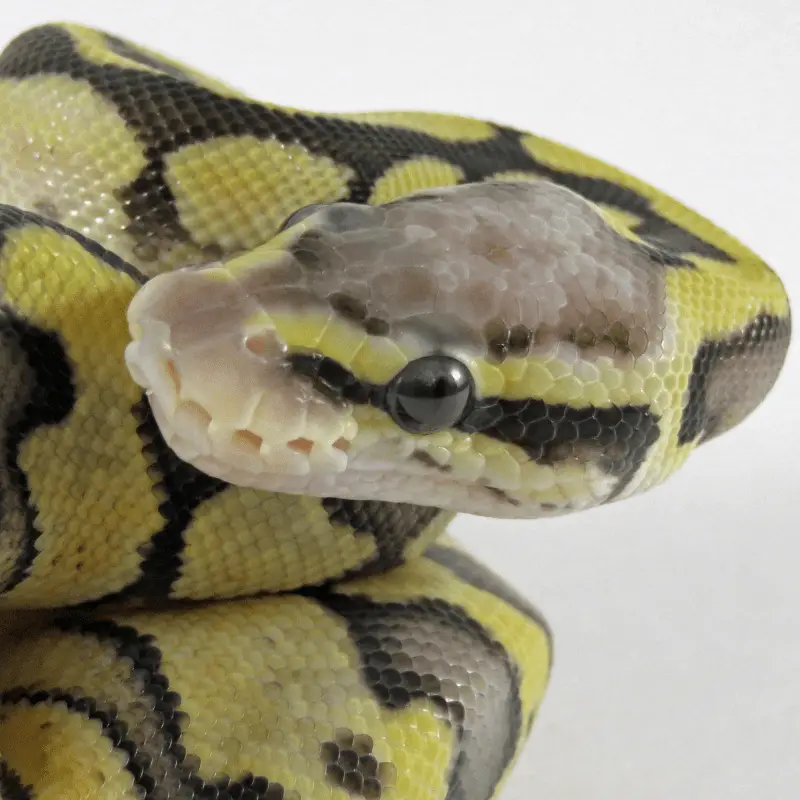
Reproduction
Compared to other snakes, the reproductive life of ball pythons is quite long. The adult snakes start to reproduce from about 27 months of age, and they remain sexually active till they become about 30 years old. The breeding season lasts from mid-September to the middle of November. The breeding season of all pythons correlates with the rainy season in Africa.
Almost three weeks after ovulation, the female ball pythons start to shed their skin. They lay eggs about four weeks later. The eggs are leathery and typically stick to each other.
Sexual Maturity
The Female ball python generally reaches their reproductive maturity when they are 27 months to 31 months old. Male ball pythons reach their sexual maturity relatively early. They become sexually active from the age of about 16 months to 18 months.
How much does a baby ball python weight when born?
A baby ball python weighs from 65 grams to 103 grams. The average weight of a baby ball python is 86 grams.
How can you tell if a ball python is male or female?
The adult female pythons are bigger than the male ones. Their sexual dimorphism is not spotted in the neonates this way. However, you can spot it easily in adults. It is possible to determine the sex of the baby ball python by placing a probe in their cloacal spurs and inside of their inverted hemipenis. In the male ball pythons case, the probe will travel deeper into the base, while for the females, it will not go as deep.
Lifespan
Reports suggest that the maximum lifespan in captivity of the ball pythons can range from twenty-eight years to up to forty-seven years. In captivity, ball pythons live for about twenty years. However, the average lifespan of these snakes in the wild is about ten years.
Behaviour
Adult ball pythons are nocturnal and solitary animals. These snakes prefer to hide in dark places during the daytime. They only come out from their hiding place at night to hunt. The captive snakes can become very docile if they are handled frequently.
Burrows created by small mammals are the favourite retreat of the ball python snakes. Compared to their female counterparts, males tend to display more arboreal behaviour. Female snakes like to stick to the ground and show mostly terrestrial behaviour.
Defence Strategy
These snakes are known for their unique defence strategy. The ball python coils up in a tight ball if threatened. They tend to tuck their head and neck right in the middle of that tight coil to create a complete ball.
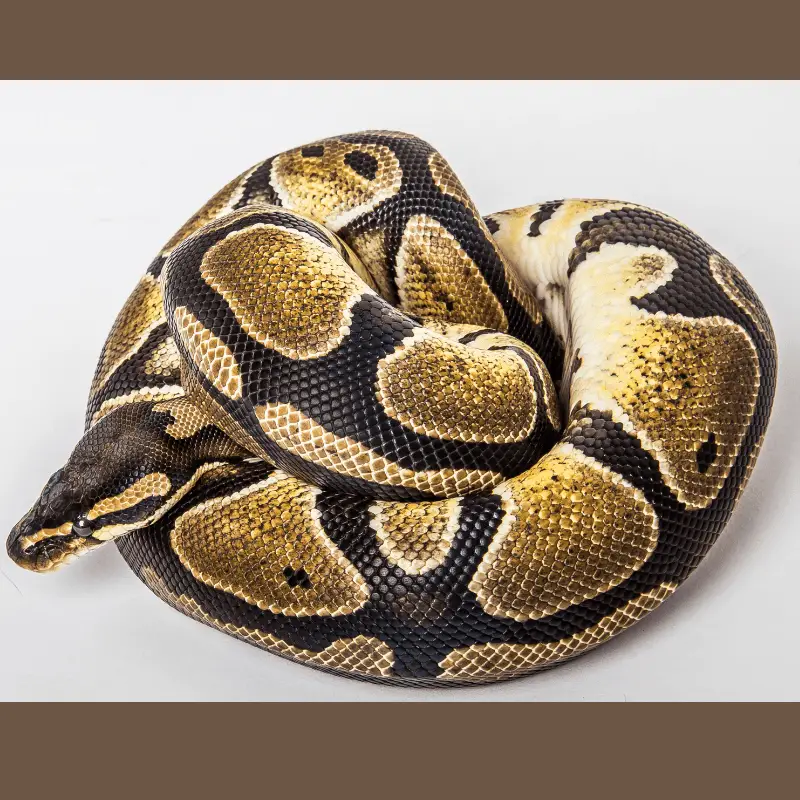
Food Habits
Ball pythons catch their prey using their extremely stretchable upper and lower jaws. Ball pythons generally sit in a hiding place and ambush their prey.
Being heavy-bodied, these snakes do not like active hunting practices and tend to use good ambience tactics. The general hunting practices are to attack the head and neck and strike the prey rapidly.
Right after striking the prey, they either swallow it alive and whole or immobilise it through constriction.
These snakes almost always feed on rodents. However, they do not need to eat regularly. Like other snakes, ball pythons are also infrequent feeders.
That is why they can control gastrointestinal functioning related to feeding and fasting. As these snakes mainly feed on rodents, they play an essential role in managing these pests. Especially in rural areas, ball pythons are necessary for managing pest infestations. The rodents that all pythons feast on the most are African giant rats, rufous nose rats, black rats, grass mice, and Shaggy rats.
Predation
Ball pythons often seek cover to try and avoid predators. They often use camouflage and bluffing displays to deter their predators. Apart from that, escape attempts and biting are some of their other techniques of avoiding predators. Some known predators of ball Python snakes are birds of prey and carnivorous mammals. Apart from them, black cobras of Africa Prey on these pythons as well. Above all, humans are the most dangerous predators that are putting these pythons at risk.
Ecosystem Roles
Ball pythons are mainly found in central and western Africa. These snakes are spotted in open forests and grasslands and sometimes in semi-built up areas.
Ball pythons love to live near open water, where they can cool themselves efficiently during the hot summer. These snakes spend most of their time inside underground burrows.
The Ball pythons are cold-blooded and they need the sun to regulate their body temperature.
These snakes are also excellent climbers, and you can often spot ball pythons soaking the rays of the sun while lounging on the top of a tree.
These snakes are primarily nocturnal and stay very active during the monsoon season. Apart from the predators, bushfires also affect ball pythons. Other than that, humans pose a severe threat to ball python snakes. Most of the time, farmers kill ball pythons out of fear.
Ticks are the primary parasite you can find on these pythons. Male carries a higher burden of ticks compared to females. The reason might be that compared to females, male snakes tend to move around more. This excessive movement heightens their risk of tick exposure. There are some internal parasites that you can also find in ball pythons, such as tapeworms and roundworms.
Captivity
The ball python is one of the most popular snake options in the world. The docile nature of these creatures has made them a favourite to pet owners. The python breeders have created many more with altered patterns and colours. Most of the wild-caught specimens do not adjust to the captive environment very well. If you try to keep a wild-caught ball python as a pet, they can refuse to feed. Other than that, wild ball pythons carry internal and external parasites.
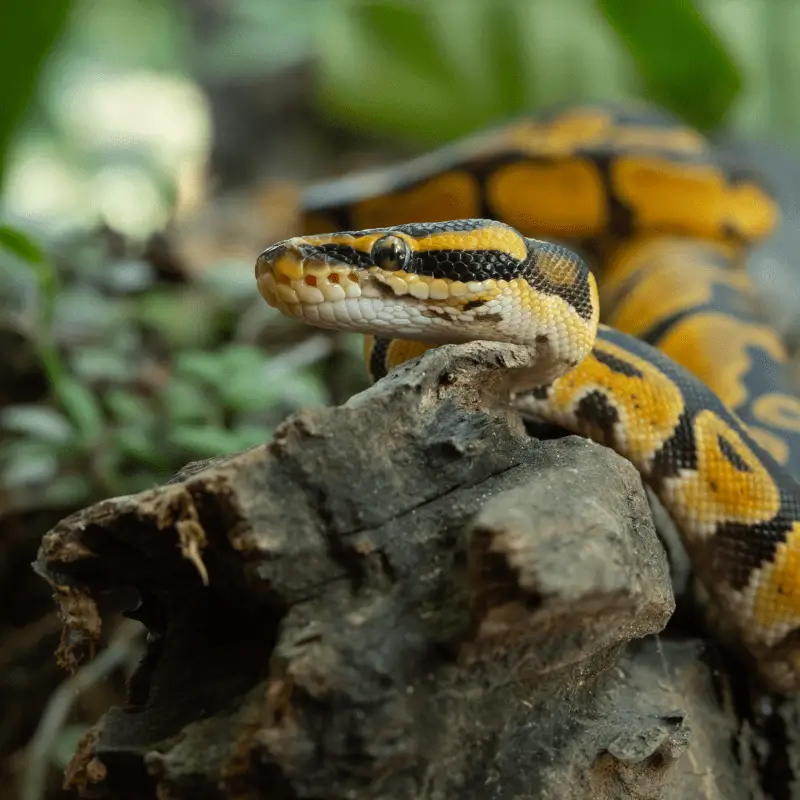
In captivity, the ball pythons can lead a long life. Even though python breeding has made the ball python a popular pet, it is often cheaper to import the snakes from the wild. Each year, tens of thousands of ball pythons are bought from West Africa for this purpose. The impact of this incident on the conservation of the native population is not that well documented yet.
Most of the captive ball pythons feed on mice and rats. Some of the pythons are feed on birds, like quail and chicken. Some keepers feed their ball python African mice, which is a natural prey of these snakes in the wild.
Even though some pet owners feed live animals to their pet ball pythons, it is not advisable. During the hunt, the defensive instinct of the prey can lead to serious injury to the snake. Young ball pythons eat more frequently. But as they grow, ball pythons tend to wait for a more extended period between two meals. A mature ball python generally eats once between 7 to 14 days. Also, these snakes do not eat while it is shedding.
Ball pythons are one of the worlds most popular snakes in captivity these days. But before you decide to adopt a ball python, you should understand them and gather as much advice as you.

